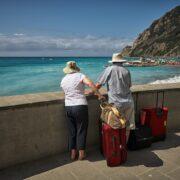QUITE often, people complain about growing old. They say they hate getting up there in age and living with wrinkles all over, deformed fingers, with the aches and pain of arthritis, diminished agility and dexterity, a limited mobility, and varying degrees of impairment of vision, hearing, and memory.
The picture portrayed above is, in general, and invariably, a description of what all of us, sooner or later, will face as we get nearer midlife, and more so as we sail through the sunset of our life. As a cardiac surgeon, I feel that as long as one does not have a serious heart ailment, severely complicated illnesses, or cancer, the changes our body and mind undergo as we grow older are as natural and “normal’ as life itself. The cycle from birth to death is a predestination none of us can escape from. In between those years, depending on our genes, and more so on our lifestyle and discipline, on how we behave, our health and longevity will vary accordingly.
In 1950-1955, global life expectancy at birth was estimated to be 46. This had risen to 65 in 2000-2005, and is 79.11 in 2023, a 0.08 percent increase from 2022. In well-developed countries, this rise in longevity is predicted to increase to 82 years by mid-century, while among less developed nations where life expectancy is under 50 years today, the projection is 66 by 2045-2050.
In the United States, there are about 56 million who are 65 and older. By 2050, it will be about 87 million. One in 10,000 people lives to be 100. In 2022, in the U.S., there were about an average of 97,914 centenarians, and this is expected to go up to 274,000 in 2025.
The life expectancy today of various races in the U.S. are as follows: Asian-American, 84.9; North Americans, 79; Middle America, 77.9; Low-income whites in Appalachia, Mississippi Valley, 75; Black Middle Americans, 72.9; Western American Indians, 72.7; Southern low-income rural Blacks, 71.2; and, high-risk urban Blacks, 71.1 years. By State, Hawaii leads the nation with the longest life expectancy at 80, and Hawaiian women at 83.2. Minnesota follows at 78.8 and Utah at 78.7.
In Tomigusuku City, Japan, a report shows that in year 2000, women lived to 89.2 years and men, to about 82, and in Wara Village of Gifu Prefecture, men lived up to 80.6 years. Besides genetic as a factor, our diet, exercise, and lifestyle as a whole most significantly determine our health and longevity.
With old age comes the signs and symptoms of normal wear and tear of any machine, and the human body is one machine that is no exception. As such, the immense tribulation that is inherent with growing old poses great limitations on the person, physically, psychologically, and socially. How the individual copes with all these difficulties depends on the lifestyle he/she has lived, his/her philosophy, discipline, and attitude in life. At 92, my mother was still watching her diet and at 97, had replaced her decades-old regimented walking with her daily home video-guided (Leslie Sansone’s Walk by the Pound) mild exercises. She passed away a year before the COVID-19 pandemic, at age 101.
Alphonse Karr put it eloquently when he wrote “Some people are always grumbling because roses have thorns; I am thankful that thorns have roses.”
Seeing only the hole in a donut, missing the ring of bread around it, or a glass as half-full and not as half-empty, defines a person’s point of view and outlook in life. I personally believe that not taking any risk at all is the greatest risk in life and that success comes only to those who have the courage to fail. The natural infirmities and difficulties that accompany old age are the risks we should all gladly accept as we face the sunset of our life with gratitude and dignity.
However challenging and often times frustrating growing older might be, the blessing of a long and fairly healthy life is a privilege. While getting old is a problem, growing old is a solution, in spite of all the aches and pains that come with the package. Life is tough, and more especially so for the seniors. Growing old is, indeed, not for sissies or the faint of heart.
But let’s be realistic and face it, we’ve got only one other option. That option is to stop aging. And the only way to achieve that alternative is to die young. Not a palatable nor a more attractive alternative, indeed. Sadly, many are denied the privilege of growing old. Since we cannot control and direct the winds in our voyage through this sometimes harsh ocean of life, we can at least, to quote a wise man, “adjust our sails,” and find happiness and peace during our journey and wherever fate takes us.
Living to the fullest with all our faculties and abilities to help ourselves and others, and be able to continue enjoying, laughing and sharing our wisdom with, and helping guide our children, grandchildren, great grandkids, and friends, making a positive difference in our society, smelling the flowers along the way, and savoring this magnificently wonderful world of ours (in spite of all man-induced imperfections and calamities), are, indeed, a sacred privilege. It is a blessing we should all look forward to with an upbeat frame of mind, and one to be truly grateful for. After all, not everyone is granted and blessed with this privilege.
So, as we enjoy the youth of our life, let’s lead a healthy lifestyle, show compassion for our less privileged fellowmen, and set good examples for our children to emulate. As years fly by, let us relish each day to the hilt, as if each day would be our last, and at the same time, let us pray for a life of good health, love, happiness, peace, and the privilege of growing old to enjoy them.
COVID-19 updates
As of 8 a.m. (EST), Tuesday, February 21, the worldwide total was 678,868,239 cases of COVID-19, with 6,792,200 deaths; USA – 104,996,288 cases, with 1,142,704 deaths; and the Philippines, 4,075,611 cases and 66,039 deaths. The average daily number of cases in the United States is still more than 39,000 (per day!) with around 430 deaths a day on average. Vaccination rate is around 82 percent; only about 34 percent have received the booster shot. The unvaccinated individuals are more likely to get infected and 4 times more likely to die from COVID-19. The XBB.1.5 is the dominant variant at 74 percent of all cases nationwide. Fully vaccinated people could still get infected, for various personal reasons, so let’s be vigilant and careful. Arrogance could kill.
* * *
The opinions, beliefs and viewpoints expressed by the author do not necessarily reflect the opinions, beliefs and viewpoints of the Asian Journal, its management, editorial board and staff.
* * *
The main objective of this column is to educate and inspire people live a healthier lifestyle to prevent illnesses and disabilities and achieve a happier and more productive life. Any diagnosis, recommendation or treatment in our article are general medical information and not intended to be applicable or appropriate for anyone. This column is not a substitute for your physician, who knows your condition well and who is your best ally when it comes to your health.
* * *
Philip S. Chua, MD, FACS, FPCS, a Cardiac Surgeon Emeritus based in Northwest Indiana and Las Vegas, Nevada, is an international medical lecturer/author, Health Advocate, newspaper columnist, and Chairman of the Filipino United Network-USA, a 501(c)3 humanitarian foundation in the United States. Websites: FUN8888.com, Today.SPSAtoday.com, and philipSchua.com; Email: scalpelpen@gmail.com.






